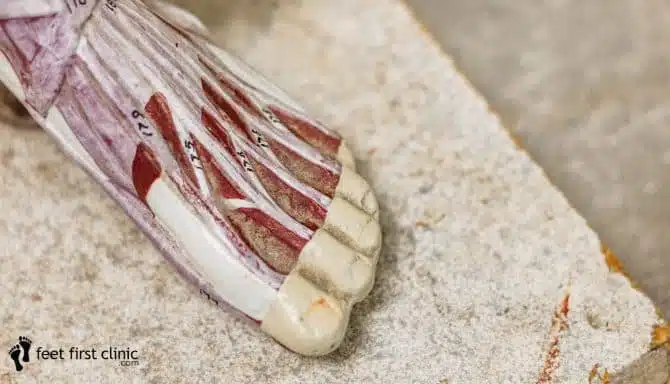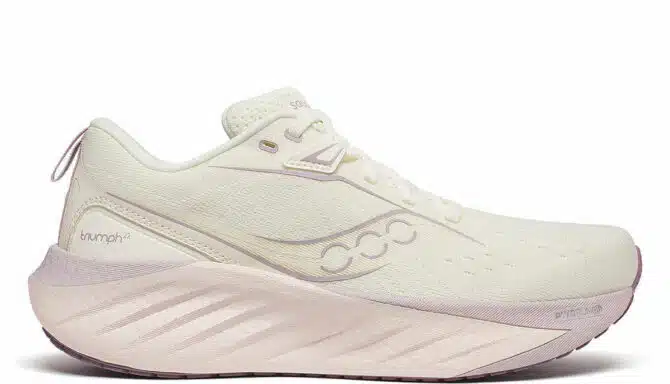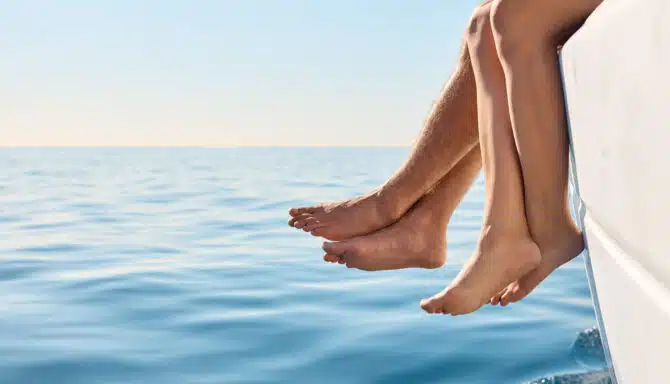Physical activity is essential to your overall health. Exercise benefits the health of the heart, body, and mind. It:
- Contributes to preventing and managing conditions such as cardiovascular diseases, cancer and diabetes;
- Enhances thinking, learning and judgement skills; and
- Reduces symptoms of depression and anxiety.
With any physical activity, there is a risk of injury. Some sports involve activities that inherently have a greater risk of injury, whereas in other sports overuse injuries are more common.
In this article, you’ll find a selection of the most common foot injuries by sport, as well as tips on how to treat and prevent each foot condition. For the purpose of this article, we’ll be focusing on injuries from the knee down, although by no means are injuries exclusive to those areas of the body.
Jump to a section for the most common foot injuries by sport:
- Running Foot Injuries
- Tennis Foot Injuries
- Basketball Foot Injuries
- Dance and Ballet Foot Injuries
- Cycling Foot Injuries
- Hockey Foot Injuries
- Soccer Foot Injuries
Common Running Foot Injuries
Hallux limitus/Hallux rigidus
Hallux rigidus in the simplest terms means stiff big toe. Limitus is the predecessor to rigidus, and is the earlier stage of toe arthritis.
Hallux rigidus/limitus occurs when the metatarsophalangeal (MTP) joint breaks down over time, often due to repetitive use. The body responds by creating bone growth as a defence mechanism. As the area becomes increasingly crowded with bony outgrowth, one loses flexibility in their big toe. The condition can then worsen over time as the bones in the forefoot begin to rub against the first bone of the big toe. This can lead to osteoarthritis and the formation of bony outgrowths called osteophytes. Stretching and exercising the muscles in your feet is the best way to prevent or manage hallux limitus and hallux rigidus. Check out our Pinterest page for some recommended exercises you can try at home.
Blisters
Less of an injury and more of a skin condition, most runners will get a blister at some point. A blister is a small pocket of fluid within the upper layers of the skin caused by excessive rubbing or friction. For runners, blisters usually develop on the toes, heels, and around the arch as these are your foot’s “hotspots”. To help prevent blisters, find proper fitting footwear, tape your feet, and use Vaseline on hot spots if necessary.
Shin splints
Shin splints are one of the most common running injuries. Running puts extreme pressure on your lower legs: Your feet absorb 2.5 to 3 times your body weight with every stride. The faster you run, the greater the weight and force absorbed by your lower body. When you ramp up your running time too quickly, and your body cannot acclimate to the change in intensity, you can develop shin splints. Shin splints are characterized by tenderness or pain along the shinbone (the front of the lower part of the leg). You can help prevent shin splints by strengthening and conditioning the muscles in your legs, and stretching before and after you run.
Click here for more information about shin splints.
Plantar fasciitis
The plantar fascia is a thick connective tissue structure that runs from your heel to your toes and supports the arch of your foot. Plantar fasciitis is a painful condition that can develop when this fascia becomes irritated or inflamed. It is one of the most common causes of heel pain. If it goes untreated and gets worse, it can eventually lead to a heel spur.
Heel spur
A heel spur is a benign bony growth on the underside of the heel bone. Plantar fasciitis is one of the most common causes of heel spurs. Heel spurs are caused by recurrent strain on the muscles, tendons, and ligaments that connect to the heel bone. In response to stress, the heel bone “fortifies” itself by depositing extra bone on the existing bone. The constant stress put on the foot puts runners at greater risk for heel spurs.
If you have persistent heel pain, schedule a diagnostic assessment with our chiropodists to identify the cause of pain.
Common Tennis Foot Injuries
Achilles tendonitis
Achilles tendonitis is a painful condition that occurs when the Achilles tendon becomes inflamed. It involves pain and swelling above the back of the heel. For tennis players, the constant back-and-forth movement along the baseline and the sprints to and from the net put your Achilles tendon at risk for overuse. The constant movement in tennis also means that there’s little time for your feet to recover in between rallies. The best form of treatment for tendonitis is rest, after which you should try returning to activities slowly and progressively.
Ankle sprains
Sprains affecting the outer ligaments of the ankle are common in tennis. You can minimize the risk by selecting shoes that are specifically designed for tennis and have substantial support built into the outer counter of the shoe.
The most effective treatment for ankle sprains is RICE (Rest, Ice, Compression, Elevation) for 24-36 hours, then walking with appropriate support on the ankle. Even after the most minor sprain, it’s recommended to play with ankle support for up to 6 weeks.
Tennis toe
Tennis toe is such a common foot condition that it has its own name (though the generic term for it would be a black toenail). Tennis toe is caused by repeated pressure or injury to the toe, causing blood to pool under the nail. It typically affects the big toe, but it can also affect the second toe. In extreme cases, a doctor, podiatrist or chiropodist can drain the pooled blood to release the pressure.
To prevent tennis toe, keep your toenails trimmed short and wear proper tennis shoes with adequate space around your toes. Taping your second and big toe together can also help.
Common Basketball Foot Injuries
Ankle sprains
Due to repeated jumping, cutting, and lateral movement, ankle sprains are extremely common among basketball players. There are three categories of sprains – low, regular and high – and three degrees of severity:
- 1st-degree sprain: a first-degree ankle sprain is when the ligaments are stretched but not torn.
- 2nd-degree sprain: a second-degree ankle sprain is the most common ankle injury. It involves a partial tear of the ligament.
- 3rd-degree sprain: a third-degree ankle sprain is the most severe ankle sprain. With this sprain, the ligament is torn completely, and you cannot move the ankle.
Low ankle sprains occur further down your leg and are typically less severe. High ankle sprains include injuries to the shinbone and the calf bone, and sometimes require surgery. Although not necessarily preventative, the RICE recovery method – rest, ice, compression and elevation – in conjunction with good medical care and diligent rehabilitation, will increase your chances of a full recovery.
Common Dance and Ballet Foot Injuries
Ankle sprains
Like many sports, lateral ankle sprains are the most common trauma injury in ballet. This stems in part from dancers spending so much time performing relevé (heel raise), which is a risk factor for developing sprains and fractures.
Trigger Toe
Trigger toe is a foot condition common among dancers – especially ballet dancers. This happens when the big toe becomes permanently flexed from an injury to the tendon controlling the toe’s movement. Because a ballerina’s big toe is routinely supporting the body’s weight, the big toe is at greatest risk of injury. Specifically, standing or pivoting in the “en pointe” position makes the likelihood of trigger toe even greater.
Sesamoiditis
This is an overuse injury involving chronic inflammation of the sesamoid bones and its adjacent tendons. Increased pressure on the sesamoids causes sesamoiditis. Often, sesamoiditis is associated with a dull, longstanding pain beneath the big toe joint. The pain comes and goes, usually occurring with certain shoes or certain activities.
Common Cycling Foot Injuries
Most cycling injuries are from trauma, but there are also overuse injuries. Because of the length of time cyclists are on their bikes – often for hours – soft tissue injuries can develop over time.
Metatarsalgia
Metatarsalgia is a generic term for pain in the ball of your foot. It is often caused by tight shoes. For cyclists, this foot condition is curbed by swapping out ill-fitting shoes for better fitting footwear and using cushioned insoles or pads.
Plantar fasciitis
Cyclists may develop plantar fasciitis from either having the saddle too low or high, or cycling with their foot at the wrong angle. Since hours can be spent in the saddle, ensuring you have the proper footwear and the proper fit on your bike is crucial for preventing overuse injuries such as plantar fasciitis or tendonitis.
Paresthesias
Paresthesia is an abnormal sensation (tingling, pricking, chilling, burning, numbness) with no apparent physical cause. For cyclists, this is often due to tight shoes or tight toe clips on the pedals.
Common Hockey Foot Injuries
Athlete’s foot
Athlete’s foot is a contagious fungal skin infection that affects the skin on the soles of the feet and between the toes. It thrives in dark, moist areas. As skates are susceptible to sweat, hockey players are at particular risk of athlete’s foot.
Ways to treat and prevent athlete’s foot are to:
- Apply over-the-counter creams that contain miconazole, clotrimazole or tolnaftate
- Dry your skates (including the insoles) after each use
- Don’t walk barefoot in the change room or shower area
- Wash your feet with soap every day.
- Change your socks regularly
- Use anti-fungal powders on your feet and in your shoes
Lace bite
Lace bite is pain at the front of the ankle or top of the foot where your laces are. When you skate, your ankle repeatedly bends forward and back, causing friction at the contact point between the tongue of the skate and your foot.
Wearing tight skates, or skates that haven’t been broken in, can cause lace bite. Most of the time, the problem is that the tongue of the skate is pressing too tightly against the tendon, which can be irritating when you try to skate around the rink. Ways to prevent lace bite include wearing gel pads on the top of your foot, loosening your skates, or changing up the way they’re laced.
Haglund’s deformity
Haglund’s deformity is an enlarged, bony bump that can develop along the back of the heel, near the base of the Achilles tendon.
This foot condition occurs where the Achilles tendon meets the heel. The enlargement can lead to bursitis, which is an inflammation of the fluid-filled sac (bursa) between the tendon and bone.
Known as the “pump bump” or “Bauer bump” after the popular skate brand manufacturer, wearing skates that aren’t fitted properly can be the culprit. Because of a skate’s rigid back heel, the pressure on the heel can lead to irritation over time. Haglund’s deformity is permanent unless surgically removed, although you can slow its growth over time. You can do this by finding proper fitting skates and avoiding hard-heeled shoes outside of hockey.
Common Soccer Foot Injuries
Turf toe
“Turf toe” is a common term to describe a sprain of the ligaments around the big toe. In essence, it’s like a sprain from repeatedly stubbing your toe. Turf toe affects athletes in other sports as well, including soccer, basketball, wrestling, gymnastics and dance.
Shin splints
As a core component of soccer, players run upwards of 5-10km per match. Running that much, including a mix of sprints and slow jogs, puts the lower leg at risk of shin splints. Shin splints, an injury most common in runners, is an inflammation of the muscles, tendons, and bone tissue around your tibia (shin bone). Click here to learn more about shin splints.
Achilles tendonitis
Achilles tendonitis can put soccer players on the shelf because of the constant sprinting and stopping. The fact that soccer players are also always moving (they only get a break at halftime and for injuries) means little time for your joints to recover between spurts.
Sports injury? We have you covered!
We’re confident in our ability to help inform you and solve your concern with the least amount of discomfort as possible. No matter the condition, we treat most common sports-related foot injuries. Contact us even to ask about a quick question and we’d be happy to point you in the right direction!
Call us at 416-769-3338 or Book Your Assessment Today!

















